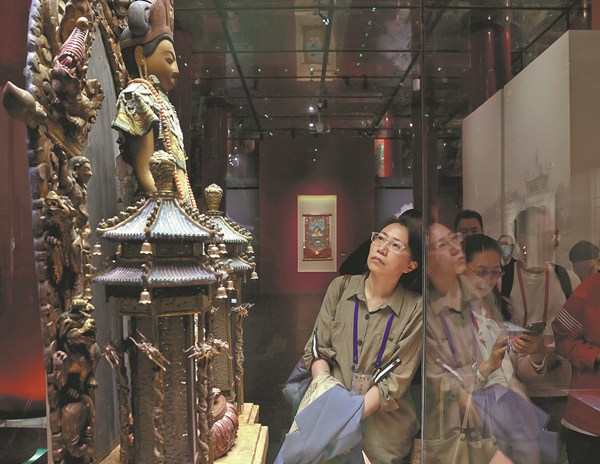
. > WHAT'S NEW > TOPLINE
Relics highlight Tibet role in China's shared identity
Author : WANG KAIHAO Source : CHINA DAILY 2023-04-29

A visitor views a sandalwood statue of Avalokitesvara Bodhisattva at the central gallery of the Meridian Gate of the Palace Museum in Beijing on Friday. [PHOTO by JIANG DONG/CHINA DAILY]
The curtain was raised on Friday at the Palace Museum in Beijing on a three-month exhibition that showcases, through physical evidence, the foundations of a shared Chinese national identity.
For Auspicious Beginnings: Joint Exhibition of Artifacts from the Palace Museum and Tibet, 108 cultural relics are on display in the museum's Meridian Gate Galleries to demonstrate the close link between Tibet and the central governments in ancient times.
The Palace Museum, also known as the Forbidden City, functioned as China's royal palace from 1420 until the end of the Chinese monarchy in 1911. It not only marks the apex of ancient Chinese architecture but, through its rich collection, also serves as a crucial witness of history.
"From a historical perspective, our studies have unveiled the frequent communications and mutual support between Tibetan people and other ethnic groups of our country," said Du Haijiang, deputy director of the Palace Museum. "The Forbidden City was just the place marking this brotherhood and evolution of a shared community of our nation."
Bunian Tu, a painting that is housed in the museum, is one of the most important items of the exhibition. The work by Yan Liben during the Tang Dynasty (618-907),which depicts a meeting between Emperor Taizong and a delegate of the Tibetan people (then known as the Tubo), has not only been hailed as a milestone in Chinese art history, but is also a vivid illustration of the link between the Tibetan people and the central Tang royal court.
Echoing this history is an exhibit from more than a millennium later: an 18th-century thangka — a traditional Tibetan painting on cotton or silk — that is a portrait of the seventh-century Tubo ruler Songtsen Gampo.
According to Wang Zilin, curator of the exhibition, a great number of secular and religious artifacts were brought to the imperial courts of the Yuan Dynasty (1271-1368), the Ming Dynasty (1368-1644) and the Qing Dynasty (1644-1911), due to close contact between Tibet and the central governments. Some revered Tibetan monks also became emperors' councilors and teachers, giving great impetus to the prospering of Tibetan Buddhism within the Forbidden City.
"Buddhist temples were all across the inner court of the imperial palace, forming a unique worshipping system," Wang said.
It is no wonder that so many Buddhist statues from the Palace Museum's inventory, ranging from the Yuan to the Qing dynasties, are exhibited in the galleries.
In addition to cultural relics from the palace's own collection, some key exhibits are on loan from museums and temples in the Tibet autonomous region, Wang said.
For example, a portrait of Zhu Di, the third emperor of the Ming Dynasty, from Potala Palace in Lhasa reminds modern viewers of his contribution to keeping close connections between the central government of the time and local leaders in Tibet.
A Ming Dynasty thangka, from the collection of the Sakya Monastery in Lhasa, is another crucial historical reference. It marks a meeting between Yuan Dynasty ruler Kublai Khan and Phagpa, a Tibetan Buddhist leader who became the imperial preceptor. During Kublai Khan's reign, Tibet became an administrative region under direct rule of the central government.
In addition to relics commemorating key political events, there are smaller items in the exhibition that nonetheless testify to the warmth of time.
One example is a wooden bowl that Emperor Kangxi received as a tribute from Tibet. He later gave it to his grandson as a gift. When the grandson stepped up to the throne and became Emperor Qianlong, he emotionally remembered the past and wrote a poem on the bowl.
Ye Shengtao made Chinese fairy tales from a wilderness
Ye Shengtao (1894–1988) created the first collection of fairy tales in the history of Chinese children’s literature...
-
How northern ethnicities integrated into Chinese nation
2023-09-18
-
Mogao caves
2023-09-12
-
Mogao Grottoes as ‘a place of pilgrimage’
2023-09-12
-
Time-honored architectural traditions in China
2023-08-29
-
Disentangling the civilizational evolution of China
2023-08-28
-
AI ethics in science fiction
2023-08-23













 2011-2013 by www.cssn.cn. All Rights Reserved
2011-2013 by www.cssn.cn. All Rights Reserved